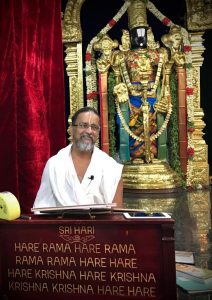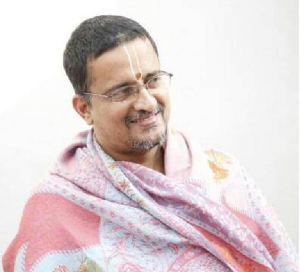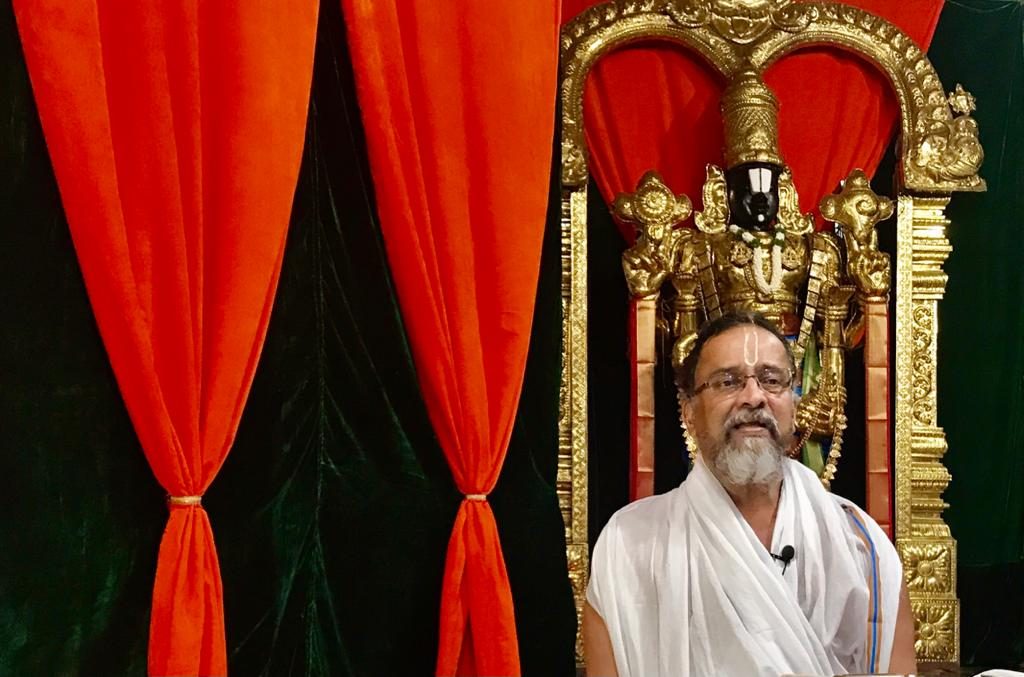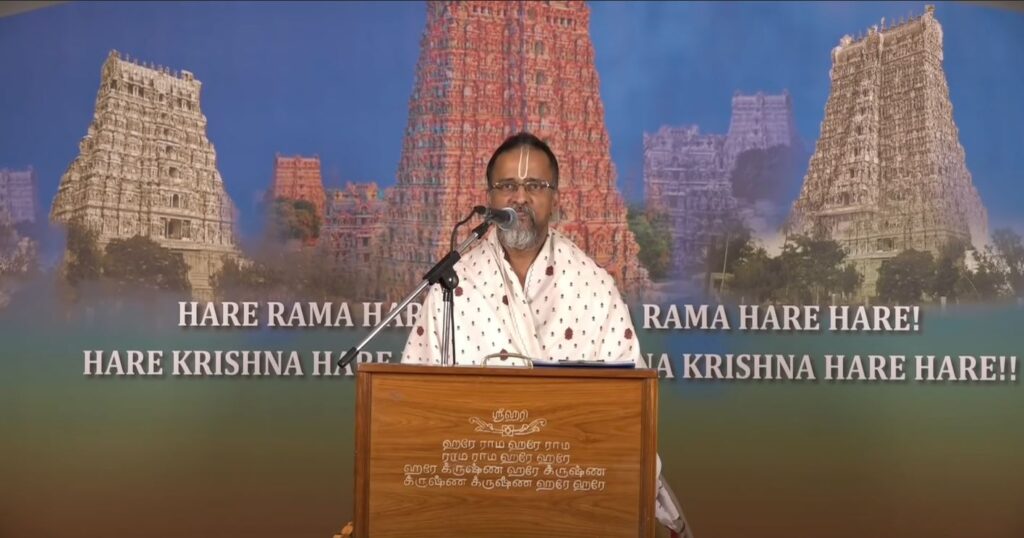This is the translated transcript of Part 1 of Sri Swamiji’s live online discourse on the auspicious occasion of the Indian New Year on Apr 14, 2021
Link to the discourse video on Global Organisation for Divinity Facebook page: https://www.facebook.com/globalorganisationfordivinity/videos/2970017786561145
 Plava Nama Samvatsaram! Today (Apr 14, 2021) is the first day of the Tamil New Year for all of us. Yesterday was Yugadi (Ugadi), and today is birth of the Tamil new year. Today is the start of the Tamil new year. Last year there was another start of the year… like this there are so many ‘new years.’
Plava Nama Samvatsaram! Today (Apr 14, 2021) is the first day of the Tamil New Year for all of us. Yesterday was Yugadi (Ugadi), and today is birth of the Tamil new year. Today is the start of the Tamil new year. Last year there was another start of the year… like this there are so many ‘new years.’
The sound of the word Yugadi itself seems to explain its meaning. What does Yugadi mean? Now this ‘yuga’ – Kaliyuga – would have started on a very first day right at the beginning. Kritayuga would have started on one day, then Tretayuga would have started, then Dwaparayuga would have started.
The day that the yuga begins is termed as Yugadi. We start calculating the years from there. So, the yuga’s ‘adi’ day is Yugadi. The first day of the Yuga. Starting from the first day of the Yuga, since the Sun resides in one rAsi (zodiac) every month and takes 12 months to go across the 12 rAsis, it’s movement from Mesha rAsi (Aries) to Meena rAsi (Pisces) is considered as one year. In one year, we have 6 ritus (seasons). With this, we are celebrating the new year today.
Every Tamil year has a name. This year is called ‘Plava.’ Plava means ‘to help cross over.’ That is why a small boat is called as plavam. This name ‘to help cross over’ is a beautiful name for this year. Today we are chanting this Mahamantra kirtan that helps us cross over this ocean of samsAra. This year’s name is appropriate and fits beautifully.
If we ask who do these 60 names (of years) belong to… in our Puranas, there are some [weird sounding] stories which may make us feel surprised or wonder about its purpose. Such stories are called artha vAdham. They are not true. But they have been told for us to retain certain things in our memory. Because only if it is linked with some stories/events, will we not forget them.
For example, on the day when srArdham (monthly or annual death rites) is performed, drumsticks (the vegetable) or drumstick greens should not be cooked/eaten. In order that we don’t forget this, our grandmothers tell us a story that the drumstick tree laughed when Sri Rama left for the forest, so it should not be included in the meal. This is not the truth, but in order for us to not to forget such rules, they said such stories. The truth is that drumsticks and its leaves, etc. kindle kAma or desires, and since the day of srArdha is one where vratha (fast, austerity) needs to be followed, it is advised that we avoid such foods. This is only the truth.
In this way, through such [made-up] small stories or events, elders impart some dharmas to us so that we don’t forget them. In this same vein, they say that these 60 names (of years) are the daughters of Sage Narada. [But the real point is that] today what we need to do is to remember Narada, on this first day.
prahlAda-nArada-parAshara-puNDarIka-
vyAsa -ambarIsha-shuka-shaunaka-bhIshmadAlbhyAn
rukmANgada-arjuna-vasishTa-vibhIshaNAdIn
puNyAnimAn parama-bhAgavatAn smarAmi
So prahlAda nArada…
Can we do anything without remembering Narada? If we start Ramayana parayana, Narada comes first. If we do Bhagavata parayana also Narada comes first. He comes first in all these charitras. It has been a custom that we have to start every new year by remembering Narada first.
If we look at the world… whether we take the charitra (history) of the world, or the history of India, some people say that during those earlier days there used be rivers of milk and honey flowing (meaning the country was prosperous and peaceful), that people in those days were all very honest, the king was just, etc. It may be nice to listen to all this, but if we look at charitram (history) itself, it is not at all like that.
In history, whether it is India’s history, world history, or even the Puranas… is it not from the Puranas that we talk about the story of King Hiranyakashipu? In the Puranas only, we talk about Vena [the wicked]. In the Puranas only we talk about the charitra of Ravana. In Puranas only we talk about the story of Asamanjan [the wicked]. In the same (famed) Raghuvamsa dynasty, Sri Rama was also there, and so was Asamanjan. In the same Raghuvamsa, both Sibi [the great] and Asamanjan were there. Right? This is what we see… in the same vamsa.
We see that in the same vamsa where Lord Vishnu’s avatara King Prithu was born, Vena was also born. In the same vamsa that the wicked Hiranyakashipu came, Prahlada was born as well, and so was Bali.
Just like life always has both sukha and dukkha (pleasure and pain), the world too is like that only. Sufferings keep coming periodically – this is how the world has always been. People have written that there were once rivers of milk and honey, people were honest, etc. But if we see honestly, the world has [always] suffered [periodically] due to the lack of rain (drought), due to too much rain (floods), due to earthquakes, etc.
In Sant Tukaram’s charitra, there was a time when people suffered a lot because of drought, and he writes about this in an abhang. When people suffered a lot, he sat on a hill on the outskirts of the town and started to do a lot of Nama japa. Then he says (in the abhang) that it rained, and all the people went back to searching for worldly pleasures, but Tukaram did not forget the vairAgya that was bestowed on him by the drought.
Today, we are witnessing this pandemic, which gives fear to all of us. So what should we do? There are lessons from every charitram. If we take Prahlad charithram, let’s see what message there is for us in it.
The first message is… who is an asura and who is a bhakta?
One who thinks that he is the body and wants to somehow strive to protect it, like Hiranyakashipu did… such a person is an asura. He thought, “I am this body. This body should not be destroyed by any means. It should not be destroyed even if someone cuts it or burns it, it should not be destroyed either on the ground or in the sky…” Why does he ask for all this? He has ajnAna (ignorance). So all who think “I am the body,” are indeed Hiranyakashipus.
Similarly, many people claim that “I am Bhagavan” even though they believe that they are the body. Such people are also ajnAnis (ignorant people); they are asuras. Only Atma (the soul) is Bhagavan. Only your svarUpam (intrinsic nature of consciousness) is that of Bhagavan. Not your body. We should understand this clearly. This is very clear from Prahlada charitram.
When Lord Narasimha appeared, all divinities including Lord Shiva from Kailasa, Lord Brahma, Indra and numerous other devas came to have His darshan. Even in the midst of all these divine personalities, Lord Narasimha called that tiny little boy Prahlada and graced and blessed him. What message does Bhagavan give us through this? Bhagavan does not value one’s position, one’s education, or one’s wealth. He values only those with immense bhakti towards Him, even if he is only a little boy. This is the second message.
Thirdly, “Where is your Narayana?” asks Hiranyakashipu to Prahlada.
In Bhagavatam, when we do parayanam of this episode, we can feel Hiranyakashipu’s words and pace quicken. Like a fast-moving snake that hisses with intense anger when stepped on, he walks up and down the hall of his palace and thunders, “Is that Hari you speak of in this pillar?” He goes up to the pillar and slams it with his fist, and Lord Narasimha appears from it!
So when Hiranyakashipu asks, “Is Hari in this pillar?”, Prahlada replies “I see Him!”
He did not say, “Bhagavan is there.” Instead he replies, “I see Him!” On the other hand, Hiranyakashipu says, “I don’t see Him.”
In Vedanta. “Sarvatra hari darshaNam” is the state of advaita (state of non-duality). The state in which Hari is not visible is the state of ignorance (ajnAna).
An elderly person comes to see Bhagavan Ramana Maharshi. He asks Sri Ramana again and again, “What is your siddhanta?”
Sri Ramana asks him, “What is your siddhanta?”
The person replies, “Seeing the whole world as Vasudeva is my siddhanta.”
Sri Ramana replies, “After seeing the whole world as Lord Vasudeva, if you don’t see yourself as Vasudeva then there is no use. If you see yourself as Lord Vasudeva, then the whole universe will become Vasudevamayam.”
So what does Hiranyakashipu do? Not recognizing himself, out of ignorance, he sees the whole universe as filled with forms and names. For Prahlada, because it is “sarvatra hari darshaNam”, he attains the state of advaiteeyam.
Now, Hiranyakashipu breaks the pillar. Immediately Lord Narasimha appears there.
What is the message for us here?
If you have an archAvatAra, and perform abhisheka, archana, adorn with jewels, take out on procession, make offerings of delicacies like tamarind rice, akkAravaDisal, etc…. and after doing all this, if you don’t have faith that Bhagavan is there in the murthy, then all this has zero result. If you clean the archAvatara with tamarind, and you don’t see a difference between cleaning kitchen utensils with tamarind and Bhagavan with tamarind, then what is the use? So that kind of puja does not give any result. It is only a show-off.
But let’s say there is a stone. If one has staunch faith that the stone is a divine deity, then sAnnidhyam (divinity) develops in the stone because of the devotee’s bhAva.
So where is Bhagavan? Is He in the murthy made of stone? Or in the murthy made of metal? Or is He in a murthy made of wood? Or in an archavataram made of gold? Or is He in water? Is He in fire? Is He in the Sun? Where is Bhagavan? He is in your faith. If there is no faith, there is no Bhagavan.
That is what is shown here. For bhaktas like Prahlada, the moment they just think “Bhagavan is there”, Bhagavan comes out. He has no doubt or hesitation. He has no second thought.
Prahlada did not think, “Oh my father has asked where Bhagavan is… so let’s call the priests, offer sandalwood paste, kumkum, garlands, perform laksharchana, do prANa pratishTha…”… He thought nothing of that sort! He just said, “Sri Hari is there!” Hiranyakashipu broke the pillar and Bhagavan appeared. What is the message for us from this? If we have faith, Bhagavan will talk from anything and from anywhere!
Next, as we continue to look at this charitra, Hiranyakashipu put Prahlada in a fire, Bhagavan came and protected him. He was given poison, Bhagavan saved him. He was thrown into the sea, Bhagavan came and saved him. He rolled Prahlada from the mountain, Bhagavan came and protected him. He did black magic against Prahlada. Bhagavan came and saved him. All this happened.
Bhagavan could have made this very simple. Hiranyakashipu was so attached to his body. Bhagavan could have simply frightened and threatened him in his dream, “Don’t you dare touch Prahlada, or else!”
Why did Bhagavan not do this? He is giving us a message.
Just like happiness and sorrow in one’s life are inevitable, happen continuously, and are completely out of our control, similarly many kinds of events will keep happening in this universe. A cruel leader will come; people will suffer. A harsh dictator may come whom we cannot question or even express our feelings… there will be so much suffering. People have had sorrows and misery because of drought, misery because of floods, been troubled by earthquakes, troubled by tsunamis…
Like all of this, now we have this pandemic. What should we do for this pandemic?
Through Prahlada charitra what message does Bhagavan convey? “Prahlada, don’t ask why he is rolling you down from hilltop, don’t ask why you were given poison, don’t ask why you were thrown into ocean. You chant Nama and I shall take care of you!” That is the message.
While chanting Nama, we need to chant and pray with the intention that Bhagavan should protect us. The prayer should be pleading. Suddenly we should not make ourselves think, “I am chanting Nama, I need Moksha”, “I am chanting Nama, I need to have chitthashuddhi,” etc. The prayer needs to be specific. You should not confuse yourself.
Look at great Mahans. They are great jnAnis. Generally, when people come to these jnanis, the mahans would simply listen to their sorrows, sufferings and bless them. They would not speak of anything else, like moksha, etc. They won’t speak of things like nerve centers in the body, nADis, kundalini, chakras, etc.
Only those who have only studied of such things will speak about them. Whereas one who has experienced these will never speak of it. Why? Because if such things are spoken of to someone who is not a sAdhaka (spiritual aspirant) or one who has not experienced it, it will only confuse and make him go crazy and will certainly not benefit him.
Then to whom should these things be spoken of? If a person is a mumukshu (one who is fervently in search of moksha) or a sAdhaka, and if he has any doubts or questions, then those doubts need to be cleared.
Otherwise, even just talking about these things can lead to people confusing themselves or imagining that they are having psychic experiences… it can go completely wrong.
[So the mahans will only bless them saying] – “Be content and happy with your family. Bhagavan will take care of you. Just chant Nama. Continue to chant a few Namas daily.”
This is how it needs to be. Only those who are capable of doing sAdhana (spiritual practices) need to be encouraged to do so. If we ask those who are unable to, to perform spiritual practices, they will only get fear, inferiority complex, or guilt. For them, Guru bhakti and Hari bhakti is enough. To whatever level they are able to do this is sufficient for them.
In Tiruvannamalai, there lived a mahatma called Yogi Ramsuratkumar. A person called Sadhu Rangarajan once interviewed him. While interviewing he asked, “You must have chanted so many Namas. You are in such a high spiritual state. You must have had several divine experiences. Why don’t you share some of those with me?”
Yogi Ramsuratkumar replied, “If I have to share those with you, then you must also be someone who has had divine experiences. Mystic experiences can be shared only with mystics. Else, even if I share, others will not understand, or they will get confused.”
[Someone who merely hears such things] will wake up the next morning and suddenly say, “I am Andal.” Or he will wake up and say, “I am Meera.” Or the next morning he will say, “I have become Ramana Maharshi.” That is state of common people.
So, we should not start from that state. What we should do is to start with chanting a few Namas regularly and being humble. We need to be like that. Whatever few Namas we can chant, let’s chant it humbly. Even the longest journey has to start with a single step.
Slowly chant starting 10 Namas, 20 Namas, 30 Namas, that’s how it has to go. So what is the message from Prahlada charitram? You chant Nama, I shall take care of you and your near and dear ones.
So what do you have to do? Mentally hold Sri Krishna’s lotus feet tightly and chanting nama, plead “Please protect me.”
When you say “please protect me” it encapsulates everything. Don’t get confused with chittashuddhi, moksha, etc. Understand? Because you need to pray for whatever you really want, with clarity, without any hesitation, without any confusion, and with courage. If you feel very weak, pray, “Please strengthen me.” Or is your mind confused or vacillating? Pray, “Please make me strong.” Do this prayer with conviction and a firm mind. Whatever you want, you must plead for it. You should not go to the highest level directly. That itself is ignorance.
So like Bhagavan shows us from Prahlada charitram, in this Plava varsha, let us chant more and more Nama. Nama is very small (easy), but the fruit it yields is very big. For many people, this nama has helped them immensely during their difficult times.
Swami Ramananda was a mahatma. His ashram was in Kasi, on the banks of Ganga. He would always keep chanting “Rama Rama Rama Rama…”. Once there was an invasion/disturbance in that kingdom. Fearing cruelty and death, many women and men came running to give up their lives in the Ganga. Seeing their sorrowful state, Swami Ramananda made them all sit there on the banks of the Ganga, asked them to chant Rama nama along with him through the night, and protected them all. This is the greatness of the Divine Name.
In the same town of Kasi, there was a Rama bhakta. He would always chant “Rama Rama…” Whenever anyone came to him with a health problem or any trouble, he would give them a notebook, himself write a few Rama Namas in red ink in it, and tell them to continue to write Rama Nama in the book while thinking mentally of their specific prayer (like “this disease should be cured”, etc.). Since he was great mahatma who himself chanted Nama incessantly, his advice gave positive results for numerous people.
So Nama is a Kalpakavruksha (wish-fulfilling tree) and a Kamadhenu (cow of plenty). We do not need to hold on to anything else.
“nAma parate sAdhana nAhI..” – “There is no greater sadhana other than Nama.”
Do not think that something else is bigger than Nama. Constantly chant Nama continuously without break. Let the mind wander around wherever it wants. Let the mind be weak. Whatever happens to the mind, keep chanting Nama. Only with Nama, will the mind gain strength. Only with Nama will any inferiority complex disappear. Whatever it is, we have to overcome it only with the Nama. So do more and more Nama sankirtan.
This Plava year is beautifully named with the meaning “to crossover.” Kali Santarana Upanishad is the name of the Upanishad for the Mahamantra. Santaranam also means “to crossover.” Plavam also means “to crossover.” So, this year, let us do plenty of Nama sankirtan and let make this life fruitful.
Today is the beautiful Tamil New Year. On this Tamil New Year, through Bhagavan’s grace, let there be auspiciousness for everyone. Let fears in people’s minds disappear. Let good health blossom. Let people live longer. Let there be prosperity for all. Let unity prevail in families. Let us all be happy, chanting Bhagavan Nama always.
When Bhagavan lifted the Govardhana mountain, all the people of Gokula were really under the shade of Bhagavan’s lotus feet. Similarly, let us also think that we are under the shade of Premikavaradan’s divine feet, do Bhagavan Nama kirtan, hold His lotus feet tightly and plead with our prayers! (whatever prayers we have.) Let us do this with utmost faith. That is the one thing that we all need to do from this New Year.
Click here to go to the main blog page and see the other discourse posts: bit.ly/madhuravaani






